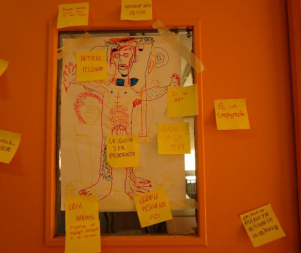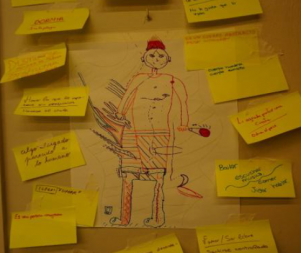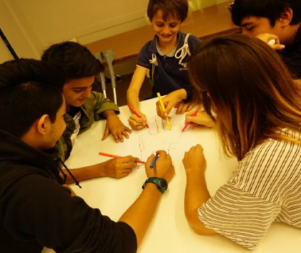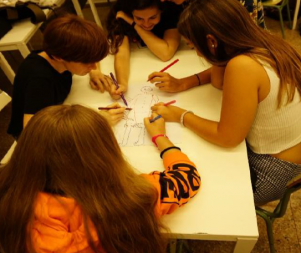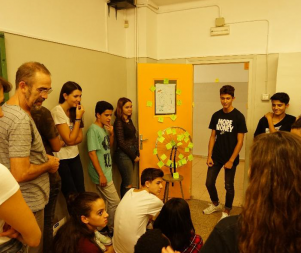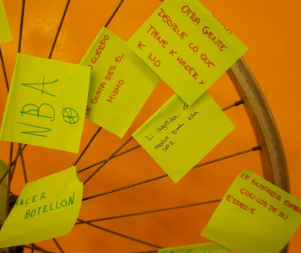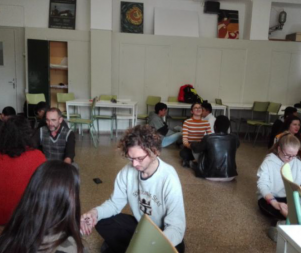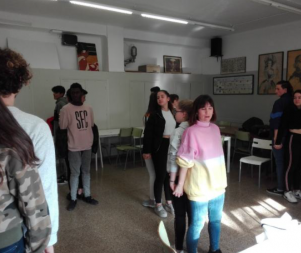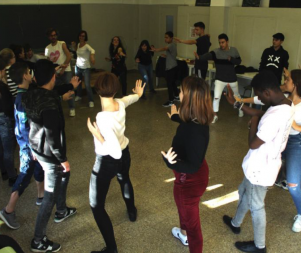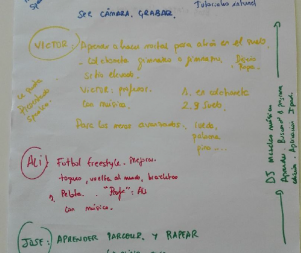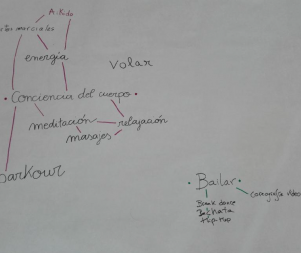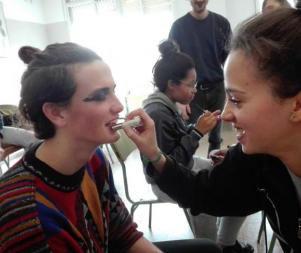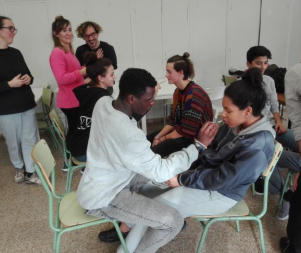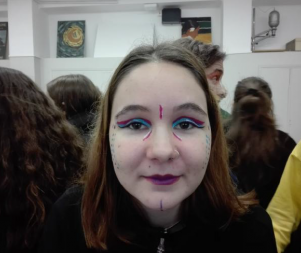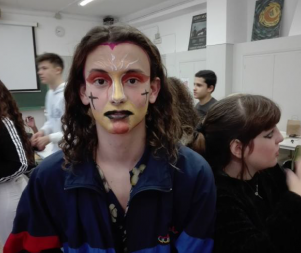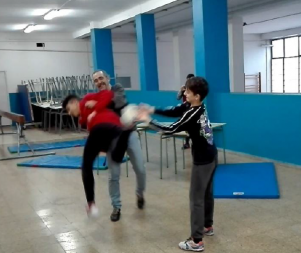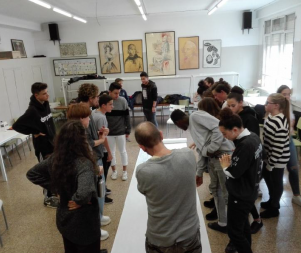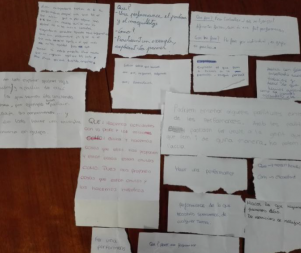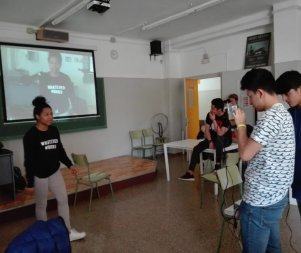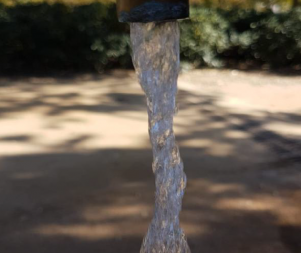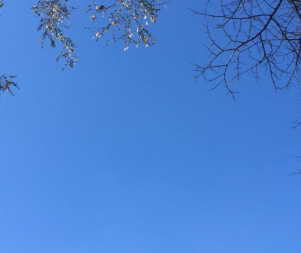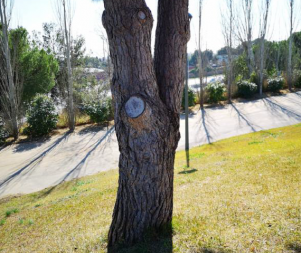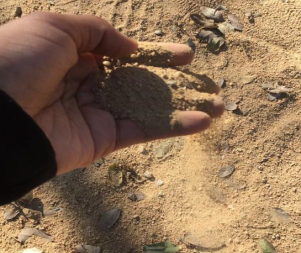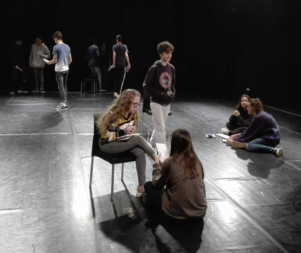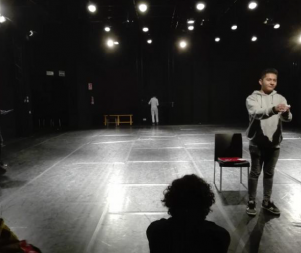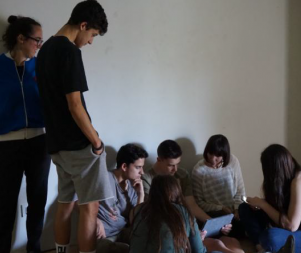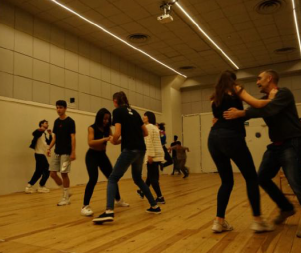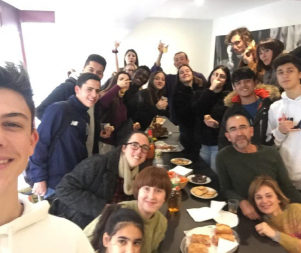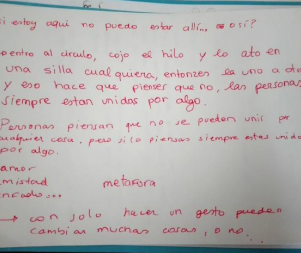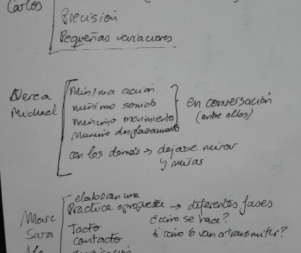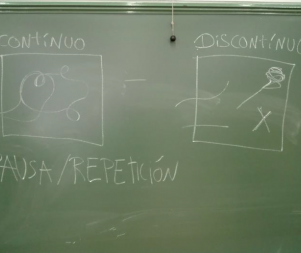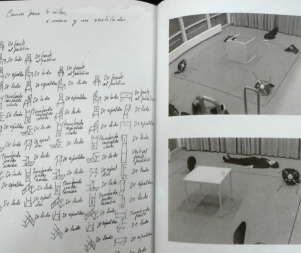- 14th EDITION 2022 / 2023
- 13th EDITION 2021 / 2022
- 12th EDITION 2020 / 2021
- 11th EDITION 2019 / 2020
- 10th EDITION 2018 / 2019
- 9th EDITION 2017 / 2018
- 8th EDITION 2016 / 2017
- 7th EDITION 2015 / 2016
- 6th EDITION 2014 / 2015
- 5th EDITION 2013 / 2014
- 4th EDITION 2012 / 2013
- 3rd EDITION 2011 / 2012
- 2nd EDITION 2010 / 2011
- 1st EDITION 2009 / 2010
Misiondivina IN RESiDENCE at the School Joan Boscà
DESCRIPTION OF THE PROCESS, OBSERVATIONS AND CONCLUSIONS
Starting point: The starting point and central idea that has guided the entire In Residence process has been the approach to artistic practices such as learning processes or, vice versa, understanding learning processes and the knowledge that is generated inside artistic practices. A premise that the Misiondivina collective, as an experimentation laboratory, had already been working on for roughly one year before La Caldera invited them to take part in the project.
“The focus of our research is on knowledge that comes, above all, from the body. By building on and comparing the different individual artistic practices of each person, we are creating frameworks for discoveries, suggestions and clues around knowledge of a body. We are interested in breaking hierarchical constructions relating to knowledge. We are also united by the ephemeral, unfathomable nature of the live arts, which leaves no ‘objectual’ trace but which is capable of creating a particular memory of experience, of the skin, in the body of whoever receives and experiences them. What moves us, apart from ourselves, is our ability to share these space-times for relating and circulating learning with other persons and contexts, whether or not they are artistic. Because we believe that life tools are distilled from artistic practices and investigations which can help us to think about other realities, other bodies. Our last project, presented in 2018 at the Teatro Pradillo in Madrid, was an invitation halfway between shared artistic practices, a collective workshop of impossible learning and the odd stage moment emergency.”
So, from the start of the journey shared with the students from Joan Boscà, we have worked on the same issues that we ourselves had raised and which we stated simply in the title of the proposal we presented at the Teatre Pradillo last year: let’s learn to do things that we don’t know how to do and which we’re very keen on learning, together. Where the individual desire for learning collectively something we don't know is the essential driving force.
This premise was conveyed to the students, first indirectly, by proposing basic guidelines and exercises for movement of the self, such as sketching collectively and simultaneously on a piece of paper, in groups of four or five people, creating the image of a strange body that was not representative of any of them, but in which everyone had put and designed something. An imagined character which we afterwards put a series of questions to and which they had fun replying to, but which we had chosen to start to get to know them as a group and as individuals.
The second premise was the conviction that all learning is intimately linked to experience, to the sensory experience of an event that depends, inevitably, on the body itself. We put our body, as a natural and common vehicle of experience, at the centre of all the practices, which we deployed and shared over the course of the school year in different ways, by:
- working on self-perception and body awareness, with proposals centred on breathing, relaxation and activation, both muscular and energetic.
- gaining awareness of the body’s position in space and in interaction with the various elements present in the classroom, both with the furniture — desks and tables — and with the architecture itself — floor and walls, working with natural light, creating moments of darkness and semi-darkness — and with the sounds that reach us from outside.
- developing physical and auditory listening, with exercises and guidelines that lead to the generation of movement and sound materials, through the voice and the handling of objects.
- both the proposals and the sessions were always intended to promote the personal connection of every group member, but with the capacity to open up to contact with the other, working in pairs, and flowing into group dynamics, as a series of individualities.
- developing attention, giving and being given space and time for listening to what was happening, for attending to what my body and the bodies of others tell me; for us it was a goal, a constant priority (and a difficulty) throughout the time we were together.
Secondly, once an climate of trust had been established, we directly posed the question of what they wanted to learn during the course, together and with us. Based on their responses, a series of fields of interest were defined which contained and organised all the proposals that the students had made.
- Body ornamentation: learning about using make-up, tattooing, manicuring, using masks and walking with high-heels.
- Dance: learning break dance, hip-hop, bachata, salsa and musical video-clip choreographies.
- Body awareness: learning how to relax, massage, Aikido and martial arts, Parkour...
- Language and verbal expression: learning Japanese, German, Portuguese, creative writing, voice and singing, composing a song.
Understanding how to tackle and share these learning processes, with such diverse interests, occupied us for a good part of our first term, as we confronted the need to separate and divide up the group at certain times so we could work on one-off aspects and take a deeper look at the practices that arose, and return them to the group during demonstration and group-exchange times.
Spaces: Owing to limitations in the study classroom at Joan Boscà's , we had to move the sessions to another location and use other parts of the school: occupying free classrooms of various sizes and features; the gymnasium, the corridors, the stairs and the theatre that they shared with the other secondary school. One session was even held outdoors, in the park located next to its facilities.
The sessions that could be coordinated and held in the La Caldera's spaces were fundamental here, especially from the second term on. Leaving the school and finding ourselves in a different context, such as a creation centre, had a very positive effect and promoted dialogue and understanding of the proposals among the students, which significantly increased their involvement, attention span and concentration. On the other hand, it enabled them to gradually introduce and work with stage-language components, such as lighting, sound and microphones, as well as visual aspects through mobile devices, video cameras and screenings. Elements which, besides the time of the final presentation, were integrated as part of the learning process, and opened up an entire field in relation to the mechanisms of perception and for understanding possible devices when it came to sharing them.
Building a climate of trust.
The group was initially made up of students from different classes who, despite being from the same school, often had little contact with one another. Throughout the In Residence programme, through experiences and dialogue between bodies, close relationships and affinities were gradually established, and eventually a climate of trust was built up, a sense of belonging to a group and shared privacy, as beneficial as it was difficult to imagine at the start of the process. Through the various practices and times of showing each other what they had been creating, subjecting themselves to the scrutiny of their classmates and their opinions and comments, their embarrassment gradually faded and a very powerful framework of respect and care was established. They declared at the last meeting, after the final presentation at the La Caldera: “We now feel we are part of a family that you (the members of Misiondivina, Cristina Riera as a mediator and even the teacher Blanca Pérez Portabella) are also part of”.
It has been an intense learning process for us as a group, a constant exploration of tools and strategies for stimulating work on the presence and porousness of our bodies, very often thought about in an almost personalised way for each student. Every day it was a challenge to persuade them and arouse their curiosity, an ongoing experiment with different proposals, imagining variations to influence and include all the body’s senses: sight, hearing, touch, voice, spoken word... To stimulate other ways of looking, listening and expressing, to connect to the body’s synaesthesia, the various ways of perceiving time. In short, to be in the present and to consciously inhabit it.
A good part of the project was centred on working calmly, with silence and breaks and to gain awareness of the expressive possibilities of modulation, in terms of volume levels and intensities, based on barely perceptible sounds, movements, actions and minimal movement in the space.
Equally important was insisting on setting precise start and end times for any action or exercise. Work that enabled us, based on micro-actions that the students themselves proposed, and by using accumulation and repetition tools, to create more complex scores and deploy them in the space. This score work was central and took up a good part of the sessions throughout the second term. At the start, it was especially difficult for them to relate to the abstraction, understand the action by itself, denuded of narrative meaning or conventional theatricality. But, finally, it was a very useful tool that enabled us to work with conveying (they were able to learn and perform the actions of others by following the scores), developing and “giving body” to a number of the proposals.

